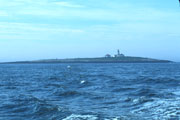
On July 30, 1998 I visited Machias Seal Island off the coast of
Maine. Machias Seal Island is part of New Brunswick, Canada and is
maintained by Canadian Coast Guard. Each year thousands of Atlantic
Puffins, Arctic Terns, and Razorbills nest here during the summer.
Three boats (two from Maine and one from Canada) are allowed to land a
limited number of people each day. I took the Canadian boat
It's called Sea Watcher from Sea
Watch Tours out of Grand Manan Island, New Brunswick. I was scheduled
to go out on Monday morning but when we were half way there the captain
decided that the weather was too bad. There's no harbor on Machias
Seal Island. To get on the island you have to take a dingy and climb
on the rocks or a boat ramp on the North side of the island. The
trip was canceled on both Tuesday and Wednesday due to bad weather.
Finally, on Thursday the boat went to Machias Seal Island. Since
there was a cancellation I was able to go.
There are no mammals on the island and it is protected from gulls and other flying predators by the Arctic Terns. The Terns are fiercely protective. Visitors have to carry a stick over their heads to prevent the Terns from attacking. This protection allows the Puffins and Razorbills to nest in relative safety.
Puffins and Razorbills are part of the Alcid family. Alcids are the Northern Hemisphere's answer to Penguins. Penguins and Alcids are among the only diving birds that use their wings to propel themselves underwater. All other birds use their feet. Since water is 800 times more dense than air it makes very different demands on the wings to fly underwater. Penguins solve this by optimizing their wings for underwater flight and giving up flying through the air altogether. Penguin's wings are very small. Alcids on the other hand have found a compromise. Their wings are relatively small and when underwater they fold them slightly to make them even smaller.
Atlantic Puffins can swim to depths of 200 feet. We know this because the occasionally they come up in fishing nets. Puffins and Razorbills only come ashore to nest. The rest of the year they live scattered throughout the North Atlantic as far south as Massachusetts. A few Atlantic Puffins nest off other islands off the coast of Maine but most that nest on the west side of the Atlantic nest closer to Newfoundland. There are many more Puffins on the European side of the Atlantic than on this side.
The other Alcids in the Atlantic are the Common and Thick-Billed Murres, the Black Guillemot, and the Dovekie. The Atlantic Puffins and the Razorbills are the only Alcids that are found only in the North Atlantic. All other Alcids are found only in the North Pacific and Arctic.
The Arctic Tern breeds in or near the Arctic (Machias Seal Island is on the southern edge of their range) and winters in the Antarctic. They have one of the longest migration of any bird.
Machias Seal Island
Machias Seal Island, NB, Canada
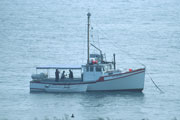
The boat from Grand Manan Island to Machias Seal Island: During most of the year this boat is used for Lobster and Scallop fishing but during the summer the captain and his mate clean the boat up and use it to take passengers Puffin and whale watching.
Machias Seal Island, NB, Canada
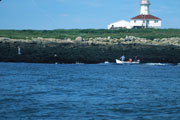
Machias Seal Island: There's no harbor so to get on or off the island you either have to climb on a launching ramp or the rocks. We used the rocks.
Machias Seal Island, NB, Canada
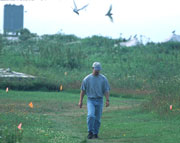
Arctic Terns: The Arctic Terns lay their eggs in the grass out in the open. They can do this because they are fiercely defensive. They make mock attacks on anything they perceive as a threat. If necessary they will actually attack. Visitors are given a stick to hold over their heads so the Terns will attack their stick instead of their head. This man works on the island so he is used to the terns and only wears a hat for protection. The Puffins and Razorbills are able to nest on the island because the Terns keep the gulls away. The flags mark the places a Tern laid an egg.
Machias Seal Island, NB, Canada
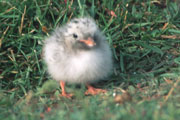
Arctic Tern chick: Arctic Terns lay their eggs on the grass out in the open.
Machias Seal Island, NB, Canada
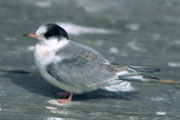
Arctic Tern chick
Machias Seal Island, NB, Canada

Arctic Tern chick
Machias Seal Island, NB, Canada
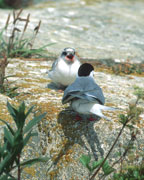
Arctic Tern feeding its chick. The parent just arrived with a fish.
Machias Seal Island, NB, Canada
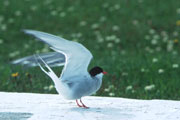
Arctic Tern
Machias Seal Island, NB, Canada
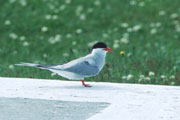
Arctic Tern
Machias Seal Island, NB, Canada
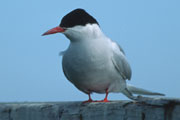
Arctic Tern
Machias Seal Island, NB, Canada
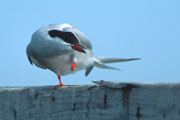
Arctic Tern
Machias Seal Island, NB, Canada
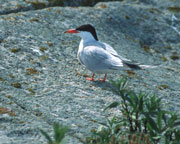
Arctic Tern
Machias Seal Island, NB, Canada
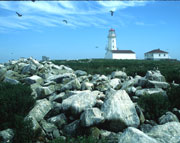
Atlantic Puffins flying past with the Machias Seal Island Lighthouse in the background.
Machias Seal Island, NB, Canada
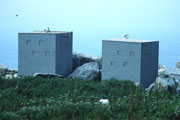
Atlantic Puffins on the blinds.
Machias Seal Island, NB, Canada
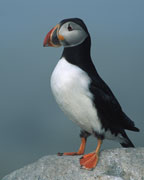
Atlantic Puffin
Machias Seal Island, NB, Canada
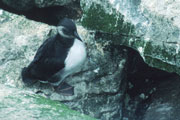
Atlantic Puffin chick: Its nest was just under the blind and it came out to look around. Normally Puffins nest in burrows they dig in the dirt. Since Machias Seal Island is basically a pile of rocks, the Puffins nest in holes between the rocks.
Machias Seal Island, NB, Canada

Immature Atlantic Puffin: This one is probably one year old. During the winter the outer parts of the beaks on adult Puffins fall off and they similar to this. Notice the metal band on its ankle.
Machias Seal Island, NB, Canada
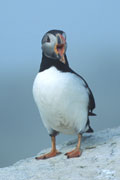
Atlantic Puffin
Machias Seal Island, NB, Canada
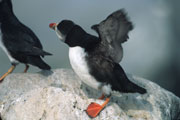
Atlantic Puffin
Machias Seal Island, NB, Canada
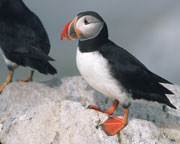
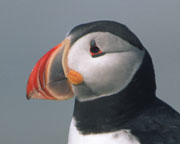
Atlantic Puffin
Machias Seal Island, NB, Canada
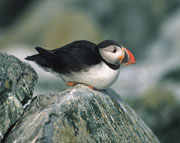
Atlantic Puffin
Machias Seal Island, NB, Canada
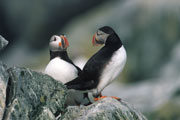
Atlantic Puffin
Machias Seal Island, NB, Canada
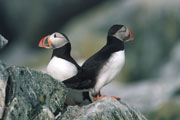
Atlantic Puffin
Machias Seal Island, NB, Canada
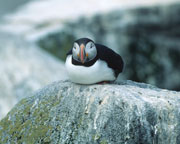
Atlantic Puffin
Machias Seal Island, NB, Canada
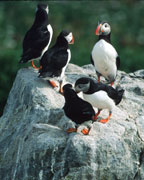
Atlantic Puffins: The Puffins below are participating in a courtship display. They're clicking their beaks together.
Machias Seal Island, NB, Canada
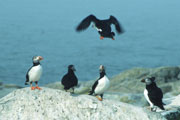
Atlantic Puffins: These Puffins are not just looking up in casual interest. A landing Puffin does not have much control. They tend to overshoot, crash into other birds, or just crash into the side of a rock. Their small wings are a compromise between flying through the air and flying under water. Because of their small wings they have to fly fast to get lift, so when they come in for a landing they use every available part of their body to slow down, including their feet.
Machias Seal Island, NB, Canada
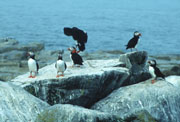
Atlantic Puffins: And just before they land they swing their feet forward.
Machias Seal Island, NB, Canada
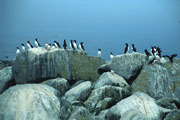
Razorbills (and a few Puffins)
Machias Seal Island, NB, Canada
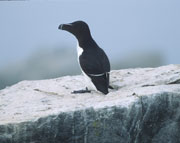
Razorbill
Machias Seal Island, NB, Canada
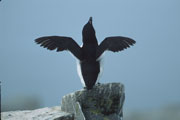
Razorbill
Machias Seal Island, NB, Canada
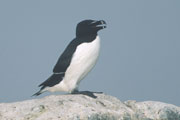
Razorbill
Machias Seal Island, NB, Canada
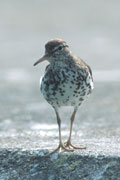
Spotted Sandpiper
Machias Seal Island, NB, Canada
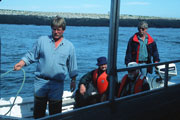
Getting back on the boat: Everyone is required to wear a lifejacket and sit down except the captain and his mate who do neither.
Machias Seal Island, NB, Canada